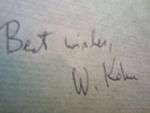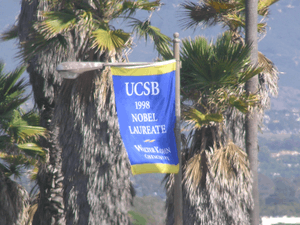Walter Kohn
Walter Kohn (German pronunciation: [ˈvaltɐ ˈkoːn]; March 9, 1923 – April 19, 2016)[3] was an Austrian-American theoretical physicist and theoretical chemist. He was awarded, with John Pople, the Nobel Prize in Chemistry in 1998.[4] The award recognized their contributions to the understandings of the electronic properties of materials. In particular, Kohn played the leading role in the development of density functional theory, which made it possible to calculate quantum mechanical electronic structure by equations involving the electronic density (rather than the many-body wavefunction). This computational simplification led to more accurate calculations on complex systems as well as many new insights, and it has become an essential tool for materials science, condensed-phase physics, and the chemical physics of atoms and molecules.[5]
Walter Kohn | |
|---|---|
 Kohn in 2012 | |
| Born | March 9, 1923 |
| Died | April 19, 2016 (aged 93) |
| Nationality | United States |
| Alma mater | University of Toronto, Harvard |
| Known for | Density functional theory KKR method |
| Spouse(s) | Lois (Adams)[1] Mara (Vishniac) Schiff[2] |
| Awards | Oliver E. Buckley Condensed Matter Prize (1961) National Medal of Science (1988) Nobel Prize in Chemistry (1998) |
| Scientific career | |
| Fields | Physics, Chemistry |
| Institutions | Carnegie Mellon University, UC Santa Barbara, UC San Diego |
| Doctoral advisor | Julian Schwinger |
| Signature | |
 | |

Early years in Canada
Kohn arrived in England as part of the Kindertransport rescue operation immediately after the annexation of Austria by Hitler.[6] He was from a Jewish family, and has written, "My feelings towards Austria, my native land, are – and will remain – very painful. They are dominated by my vivid recollections of 1 1/2 years as a Jewish boy under the Nazi regime, and by the subsequent murder of my parents, Salomon and Gittel Kohn, of other relatives and several teachers, during the Holocaust. ... I want to mention that I have a strong Jewish identity and – over the years – have been involved in several Jewish projects, such as the establishment of a strong program of Judaic Studies at the University of California in San Diego."[7][5]
Because he was a German national, he was transferred to Canada in July 1940 after the outbreak of World War II. As a 17-year-old, Kohn travelled as part of a British convoy moving through U-boat-infested waters to Quebec City in Canada; and from there, by train, to a camp in Trois-Rivières. He was at first held in detention in a camp near Sherbrooke, Quebec. This camp, as well as others, provided a small number of educational facilities that Kohn used to the fullest, and he finally succeeded in entering the University of Toronto. As a German national, the future Nobel Laureate in Chemistry was not allowed to enter the chemistry building, and so he opted for physics and mathematics.[7]
Scientific career
Kohn received a war-time bachelor's degree in applied mathematics at the end of his one-year army service, having completed only 2½ out of the 4-year undergraduate program, from the University of Toronto in 1945; he was awarded an M.A. degree in applied mathematics by Toronto in 1946. Kohn was awarded a Ph.D. degree in physics by Harvard University in 1948, where he worked under Julian Schwinger on the three-body scattering problem. At Harvard he also fell under the influence of Van Vleck and solid state physics.
He moved from Harvard to Carnegie Mellon University from 1950 to 1960, after a short stint in Copenhagen as a National Research Council of Canada post-doctoral fellow. At Carnegie Mellon he did much of his seminal work on multiple-scattering band-structure work, now known as the KKR method. His association with Bell Labs got him involved with semiconductor physics, and produced a long and fruitful collaboration with Luttinger (including, for example, development of the Luttinger-Kohn model of semiconductor band structure). In 1960 he moved to the newly founded University of California, San Diego, held a term as the physics department chair,[8] and remained until 1979. It was during this period, he, along with his student Chanchal Kumar Majumdar developed the Kohn–Majumdar theorem related to Fermi gas and its bound and unbound states.[9][10] He then accepted the Founding Director's position at the new Institute for Theoretical Physics in Santa Barbara. He took his position as a professor in the Physics Department at the University of California at Santa Barbara in 1984; where he worked until the end of his life.
Kohn made significant contributions to semiconductor physics, which led to his award of the Oliver E. Buckley Prize by the American Physical Society. He was also awarded the Feenburg medal for his contributions to the many-body problem. His work on density functional theory was initiated during a visit to the École Normale Supérieure in Paris, with Pierre Hohenberg, and was prompted by a consideration of alloy theory. The Hohenberg–Kohn theorem was further developed, in collaboration with Lu Jeu Sham, to produce the Kohn-Sham equations. The latter is the standard work horse of modern materials science,[11] and even used in quantum theories of plasmas.[11] In 2004, a study of all citations to the Physical Review journals from 1893 until 2003, found Kohn to be an author of five of the 100 papers with the "highest citation impact", including the first two.[12]
In 1957, he relinquished his Canadian citizenship and became a naturalized citizen of the United States.
In 1963 Kohn became a Member of the American Academy of Arts and Sciences and in 1969, a Member of the National Academy of Sciences. In 2011, he became an honorary member of the Austrian Academy of Sciences (ÖAW). He was also a Member of the International Academy of Quantum Molecular Science.
Death
Kohn died on April 19, 2016 at his home in Santa Barbara, California from jaw cancer, at the age of 93.[13][14][5]
Honors and awards
- Oliver E. Buckley prize in Solid State Physics (American Physical Society, 1961)
- Davisson-Germer Prize (American Physical Society, 1977)
- National Medal of Science (1988)
- Nobel Prize in Chemistry (1998)
- Elected a Foreign Member of the Royal Society (ForMemRS) in 1998[15][16][17]
- Austrian Decoration for Science and Art (1999)[18]
- Grand Decoration of Honour in Silver with Star for Services to the Republic of Austria (2008)[19]
- Harvard University awarded him an Honorary Doctor of Science (May 2012)[20]
Selected publications
- W. Kohn, An essay on condensed matter physics in the twentieth century, Reviews of Modern Physics, Vol. 71, No. 2, pp. S59-S77, Centenary 1999. APS
- W. Kohn, Nobel Lecture: Electronic structure of matter — wave functions and density functionals, Reviews of Modern Physics, Vol. 71, No. 5, pp. 1253–1266 (1999). APS
- D. Jérome, T.M. Rice, and W. Kohn, Excitonic Insulator, Physical Review, Vol. 158, No. 2, pp. 462–475 (1967). APS
- P. Hohenberg, and W. Kohn, Inhomogeneous Electron Gas, Physical Review, Vol. 136, No. 3B, pp. B864-B871 (1964). APS
- W. Kohn, and L. J. Sham, Self-Consistent Equations Including Exchange and Correlation Effects, Physical Review, Vol. 140, No. 4A, pp. A1133-A1138 (1965). APS
- W. Kohn, and J. M. Luttinger, New Mechanism for Superconductivity, Physical Review Letters, Vol. 15, No. 12, pp. 524–526 (1965). APS
- W. Kohn, Theory of the Insulating State, Physical review, Vol. 133, No. 1A, pp. A171-A181 (1964). APS
- W. Kohn, Cyclotron Resonance and de Haas-van Alphen Oscillations of an Interacting Electron Gas, Physical Review, Vol. 123, pp. 1242–1244 (1961). APS
See also
References
- Emma Stoye (22 April 2016). "Chemistry Nobel laureate Walter Kohn dies aged 93 | Chemistry World". Rsc.org.
- Newhouse, Alana (April 1, 2010). "A Closer Reading of Roman Vishniac". The New York Times. Archived from the original on October 23, 2015.
- "Memos | Office of the Chancellor". Archived from the original on May 13, 2016. Retrieved April 21, 2016.
- From Exile to Excellence Archived May 31, 2011, at the Wayback Machine, by Karin Hanta (Austria Culture Vol. 9 No. 1 January/February 1999)
- Sham, Lu J. (2016). "Walter Kohn (1923–2016) Condensed-matter physicist who revolutionized quantum chemistry". Nature. 534 (7605): 38. Bibcode:2016Natur.534...38S. doi:10.1038/534038a. PMID 27251269.
- "Walter Kohn, onetime refugee who became Nobel laureate in chemistry, dies at 93". Washington Post. Archived from the original on May 31, 2016. Retrieved April 25, 2016.
- "Walter Kohn – Biographical". Nobel Prize Organization. Archived from the original on June 13, 2017.
- UCSB Physics Department Website Archived 2010-06-19 at the Wayback Machine 'W. Kohn, BIOGRAPHICAL DETAILS'
- "Chanchal Kumar Majumdar (1938–2000) – An obituary" (PDF). Current Science. July 2000. Archived (PDF) from the original on July 17, 2006.
- Matthias Scheffler; Peter Weinberger (June 28, 2011). Walter Kohn: Personal Stories and Anecdotes Told by Friends and Collaborators. Springer Science & Business Media. pp. 264–. ISBN 978-3-642-55609-8.
- E. K. U. Gross and R. M. Dreizler, Density Functional Theory, Plenum 1993
- Redner, S. Citation Statistics From More Than a Century of Physical Review 2004 Redner, S (2004). "Citation Statistics from More Than a Century of Physical Review". arXiv:physics/0407137.
- Pernett, Stephanie (April 22, 2016). "UCSB Professor and Nobel Laureate Walter Kohn Passes Away at 93". Daily Nexus. Santa Barbara, California. Archived from the original on April 23, 2016. Retrieved April 22, 2016.
- "Walter Kohn, Nobel-Winning Scientist, Dies at 93". The New York Times.com. April 25, 2016. Archived from the original on April 30, 2016. Retrieved April 25, 2016.
- "Fellows of the Royal Society". London: Royal Society. Archived from the original on March 16, 2015.
- "Fellowship of the Royal Society 1660–2015". Royal Society. Archived from the original on October 15, 2015.
- Hohenberg, Pierre C.; Langer, James S. (March 28, 2018). "Walter Kohn. 9 March 1923—19 April 2016". Biographical Memoirs of Fellows of the Royal Society. 64: 249–259. doi:10.1098/rsbm.2017.0040. ISSN 0080-4606.
- "Reply to a parliamentary question" (PDF) (in German). p. 1305. Archived (PDF) from the original on October 22, 2012. Retrieved November 19, 2012.
- "Reply to a parliamentary question" (PDF) (in German). p. 1874. Archived (PDF) from the original on October 22, 2012. Retrieved November 19, 2012.
- "Eight receive honorary degrees". Archived from the original on June 29, 2012. Retrieved July 6, 2012.
External links
| Wikimedia Commons has media related to Walter Kohn. |
| Wikiquote has quotations related to: Walter Kohn |
- "Quantum Chemistry Comes of Age," The Chemical Educator, Vol. 5, No. 3, S1430-4171(99)06333-7, doi:10.1007/s00897990333a, © 2000 Springer-Verlag New York, Inc.
- Freeview video interview with Walter Kohn by the Vega Science Trust
- Walter Kohn on Nobelprize.org including the Nobel Lecture, January 28, 1999 (a year later) Electronic Structure of Matter – Wave Functions and Density Functionals
- Kohn's faculty website at University of California-Santa Barbara. Retrieved November 11, 2006.
- Obituary
- Hohenberg, Pierre C.; Langer, James S. (2016), "Walter Kohn", Physics Today, 69 (8): 64, Bibcode:2016PhT....69h..64H, doi:10.1063/PT.3.3274
Further reading
- Andrew Zangwill (2014). "The education of Walter Kohn and the creation of density functional theory". arXiv:1403.5164 [physics.hist-ph].
